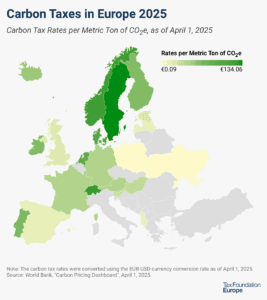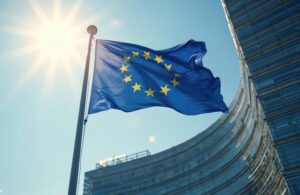
A Mis-STEP for the European Union: The New Subsidy Race to the Bottom
4 min readBy: ,Enhancing the European Union’s competitiveness is necessary, but the European Commission’s latest attempt is the wrong approach.
On July 10th, the General Affairs Council of the European Union met to discuss the Commission’s package to promote the EU’s long-term competitiveness in critical technologies: Strategic Technologies for Europe Platform (STEP). If adopted, the proposal would harm both intra-Union cohesion and economic growth and undermine a level playing field, without necessarily achieving its geopolitical ambitions. It is a Union misstep, but it is not too late to change course.
A Subsidy Race to the Bottom
The recent adoption of the OECD’s Pillar Two and the EU’s relaxing of state aid rules—most notably through its Temporary Crisis and Transition Framework (TCTF)—have shifted policymakers’ focus from competing with lower taxA tax is a mandatory payment or charge collected by local, state, and national governments from individuals or businesses to cover the costs of general government services, goods, and activities. rates to competing with subsidies. Often referred to as the “tax race to the bottom” (better characterized as a race to the mid-20s), this transition has the unintended consequence of triggering two types of subsidy races. The first: a global race where the Union tries to compete with China or the United States’ InflationInflation is when the general price of goods and services increases across the economy, reducing the purchasing power of a currency and the value of certain assets. The same paycheck covers less goods, services, and bills. It is sometimes referred to as a “hidden tax,” as it leaves taxpayers less well-off due to higher costs and “bracket creep,” while increasing the government’s spending power. Reduction Act (IRA). And the second: a race to the bottom within the European Union, where Member States compete with one another. Unfortunately for the Union, it loses in both.
This subsidy-driven industrial policy is fiscally unsustainable, ignores market dynamics, and sacrifices longer-term reforms focused on the future in support of whatever trendy industry is in the headlines.
Creating Imbalances and Distortions within the Single Market
This new race to the bottom encourages unhealthy competition that compromises fiscal stability and fairness among Member States. The majority of STEP’s financing would come from a re-prioritization of existing EU funds, such as from Horizon Europe and the Cohesion Fund. The Commission also proposed fresh money from a top-up from Member States of around EUR 10 billion.
But this figure doesn’t mean the same thing for every Member State. Countries with larger fiscal capacity or better credit ratings, such as Germany, can borrow without needing to rely on EU-wide funds to engage in these types of industrial policies. Just a few weeks ago, Germany granted an enlarged subsidy package worth about EUR 10 billion (USD 10.9 billion) to Intel Corp for a semiconductor facility in Magdeburg. This spending by a single Member State corresponds almost to the cent with the expected fresh money that would be brought to STEP if adopted. This shows the large disparity across Member States when it comes to the ability to spend on subsidies.
Additionally, a tool like STEP would only widen the gap between EU Member States. The Cohesion Fund is meant to reduce the imbalances between Member States, but STEP reprioritizes the money and creates imbalances and distortions within the Single Market. This dangerously undermines the very principles the Single Market was built upon.
The rules undergirding the Single Market are far from perfect, but one goal is to limit the sort of market-distorting state subsidies that STEP directly endorses.
The question then arises: is it worth prioritizing European industrial champions on the global stage if it means undermining EU cohesiveness? The answer is complex and ultimately a decision for policymakers. But it is worth examining whether this proposal would even attain its geopolitical goal.
Compared to other global economic powers, such as the United States or China, the EU faces challenges in raising substantial subsidy funds due to its limited taxing power and lack of complete fiscal union. The EU heavily relies on Member States for its own resources, mainly through the GNI-based resource, which provides around 70 percent of the EU’s budget. While capable of borrowing from international capital markets, the Commission’s proposal requests Member States contribute more from their national budgets to this tool.
Since approval of STEP requires unanimous agreement from 27 countries, its enactment will require considerable political maneuvering.
With the EU’s limited fiscal capacity and the unlikely top-up of EUR 10 billion, the EU is at a disadvantage compared to other initiatives, such as the United States’ Inflation Reduction Act, which contains around USD 500 billion in new spending and tax credits, or China’s USD 546 billion invested in clean energy in 2022. Until it strengthens its own capacity—through completion of the Capital Markets Union (CMU) for instance—the EU cannot compete.
It is crucial to question who the EU is truly helping with this approach. The subsidy race to the bottom and the distortion of the Single Market raise doubts about the long-term effectiveness of this strategy. Perhaps pro-growth growth tax reforms aimed at enhancing competitiveness and promoting innovation could be a more viable alternative to subsidies.
By focusing on comprehensive reforms, the EU can position itself as a global leader in strategic technologies while ensuring fairness, sustainable growth, and a level playing field within the Single Market. Without these, the EU will be stuck in a spending war with much larger global players, while simultaneously undermining its internal cohesiveness.
Share this article




